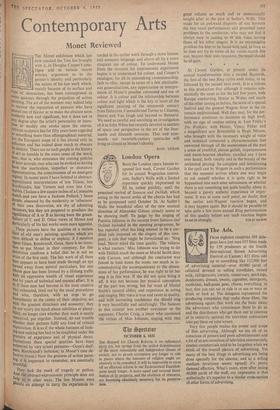Contemporary Arts
Monet Reviewed
TFt. Monet exhibition which has now reached the Tate has brought with it, in Douglas Cooper's cata- logue arid in various recent articles, arguments as to the painter's identity and particularly the nature of his late work which, suddenly new and significant, but it does not in any degree alter the artist's personality or inten- tion or modify one stroke upon the canvas. sketch and you have a Jackson Pollock.') Some sciine quarters through the prejudices of action Painting. The art of the moment may indeed help to recover the reputation of painters who have Passed out of favour or to make the obscure seem African sculpture has for fifty years been regarded been the inarticulate, imperfect or immature representatives, the consciousness of an emergent expressionist interpretations of late Titians, late stables. (Isolate a few square inches of a Constable Pe°Pie, obsessed by the modernity or 'otherness' ancestors, -but they are prepared to proclaim the significance of A or B as having been the grand- fathers of C and D. Other views of Monet and tYPe of abstraction, has been reinterpreted in Fut the European usage of it has altered only its Fafluence and has indeed done much to obscure Its identity. There are no such people in the history Of art as heralds in the exact sense of the word, Men, that is, who announce the coming policies of later arrivals, men who can be evoked as having regime. In recent years I have listened to abstract- kembrandts, late Turners and even late Con- uf their own discoveries, are shy of admitting s something more than ethnographical material,
mainly because of its surface and Particularly of his last works seem more apposite. . These pictures have the qualities of a certain
icind of old man's painting, qualities which are Most difficult to define or explain; if I mention ,Et.gain Titian, Rembrandt, Goya, there is no inten- tion to put Monet in their company, for this exhibition confirms a belief that he is not an artist of the first rank. The late work of all these men appears to have been made through an eye turned away from natural particulars, but one Whose gaze has been formed by a lifelong traffic With an oppressive wealth of visual experience and by years of technical and manual effort. It is as if these men had become in the most creative Way exhausted, tired out by the usual procedures ,nd who, therefore, with an urge to go irrtmediately to the centre of their objective, act With the greatest directness and economy; they do not worry too much about subtleties or plausi- bility, no longer care whether their work is neatly conceived, put together, finished, do not trouble Whether their pictures fulfil any kind of critical c.xPectation. It is as if the whole business of look- ing and making has had to be simplified under the Pressure of experience and of physical decay. Sometimes these special qualities have - been enhanced by very actual pressures—Goya's deaf-
Rembrandt's isolation; in Monet's case de- !ective vision.) Now the gestures of action paint- ing, it is important to remember, are essentially Youthful.
They lack the mark of tragedy or pathos. And the abstract-expressionist principle does not nelP us in other ways. The late Monets were 144inly an attempt to carry the experiences re- corded in the earlier work through a more intense and sensuous language and above all by a more eloquent use of colour. To understand Monet from the moment his impressionist experiment begins is to understand his colour, and Cooper's catalogue, for all its painstaking connoisseurship, - fails to offer, except in terms of a few platitudin- ous generalisations, any appreciation or interpre- tation of Monet's peculiar command and use of colour. It is colour and the relationship between colour and light which is the key to most of the significant painting of the nineteenth century from Delacroix, Constable and Turner to Cezanne, Seurat and Van Gogh and beyond to Bonnard. We need as careful and searching an investigation of it as John White has recently devoted to matters of space and perspective in the art of the four- teenth and fifteenth centuries. That and nine- teenth- not twentieth-century spectacles will bring us closest to Monet's identity.
BASIL TAYLOR






















































 Previous page
Previous page